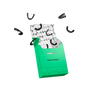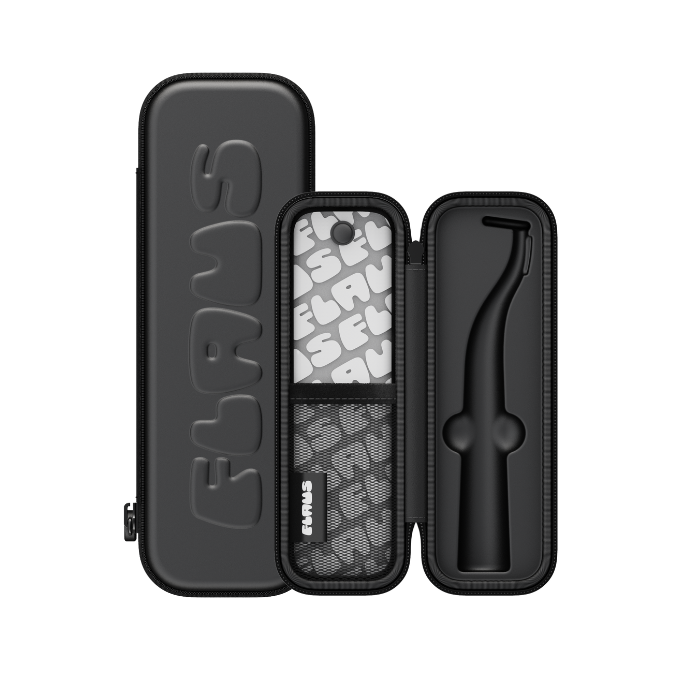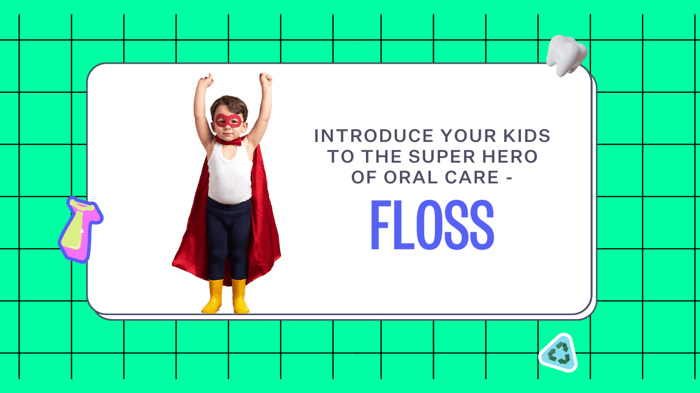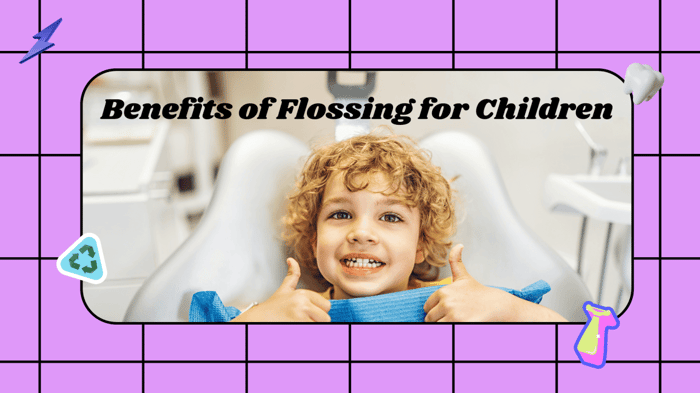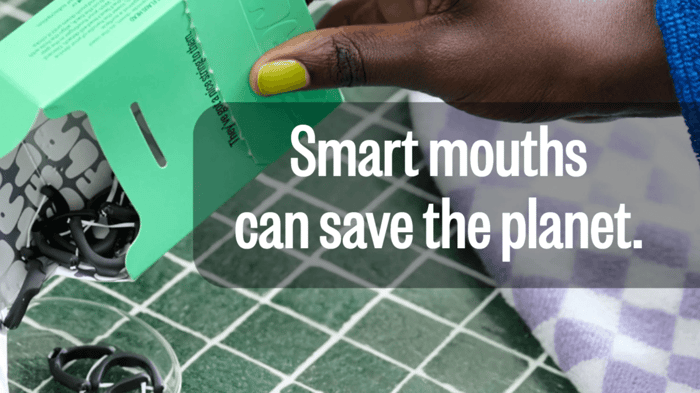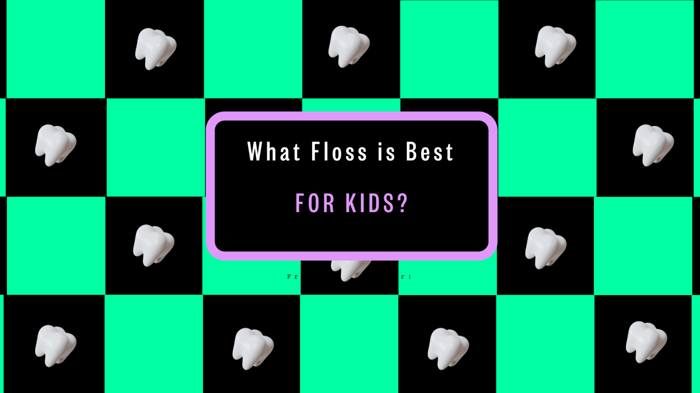Do you have a little one who loves flossing? Although we'd love to think the answer is 'yes!', we totally understand that getting a child to floss (something that 30% of adults admit to skipping), might be an upward battle 😅. Over half (52%) of children aged 6-8 have had a cavity in their baby teeth and here in Flaustopia, our goal is to change that! Flossing helps prevent cavities, gum diseases, and bad breath - but we know that it might need a bit of a 're-brand' to get your kids on board! So, today we're here to answer the age old question: How to Get Kids to Floss!
Getting kids to floss regularly can be fun and rewarding. Try making it a family activity, using fun tools, flavored floss, or implementing a reward system like a flossing chart to motivate children to develop good oral hygiene habits. Remember, consistency and positive reinforcement are key to instilling healthy flossing habits in kids.
Set a Good Flossing Example

Kids are spunges and absorb behavior from those around them, so, one answer to our question 'how to get kids to floss' is to lead by example. That's why when it comes to flossing, showing them how it's done is crucial. Every time you floss, make sure they see it. You don't have to turn it into a big production—it can be as simple as mentioning it casually or including them in the routine in a fun way.
Next time you're about to floss your teeth - let them try too! This achieves two things: First, it lets you show off your skills, and second, it makes them feel involved and helps them become familiar with the process.
In addition to showing them how to floss properly, share with them the reasons why flossing is important for your health—it's not just something painful and annoying you do before bed. Kids are curious and if they understand why something is important, they're more likely to want to do it themselves. You can tell them how flossing helps keep their teeth clean and healthy and can prevent cavities and gum problems.
It may not always be easy to remember to do this regularly. As we're all busy, days go by quickly and things slip our minds. It might feel like they're picking up on other habits like saying please and thank you but not this one. But remember it takes time for habits to form. Give them some time and keep making an effort.
Being a positive role model is a great way to encourage kids to adopt smart dental habits. Showcasing consistent flossing routines not only teaches children directly but also sets an influential example for lifelong oral health practices.
Importance and Benefits of Flossing
Here is an easy way to explain to the children in your life how important flossing is: flossing is like a secret agent, sneaking in between your teeth to clear out the stuff that your toothbrush misses—food particles and plaque. Food particles love to hide in the tight spaces between your teeth where brushes can't reach, and if they aren't evicted, they team up with bacteria to form a sticky layer called plaque.
The Dental Dance of Decay
Plaque doesn't play nice and can lead to cavities when it clings to teeth for too long. But that's not all; this party crasher can also cause gum disease. When plaque isn't removed, it hardens into tartar, which is even harder to clean away without a professional's help. This can cause inflammation of the gums and, if left untreated, it can advance to periodontitis.
But here's where our secret agent, floss, comes in to save the day. By removing trapped food and plaque between teeth and along the gum line, you're swooping out all the potential troublemakers before they've had a chance to start any problems.
Crystal-Clear Benefits of Flossing
By emphasizing these benefits to kids, adults can show them how flossing isn't a chore, but instead a superpower for their smiles. It helps prevent cavities (who wants those?!), keeps gum disease at bay, and even wins the battle against bad breath by removing the culprits behind it.
Just like brushing their teeth twice daily keeps them looking and feeling great, flossing acts as a sidekick to fully commandeer their own oral health. By showcasing why flossing plays such an important role in maintaining good oral hygiene from an early age, children learn both the importance and rewards of incorporating this habit into their daily routine.
Whether it’s through exciting stories about defending their teeth from "sugar bugs" or using fun flavors and characters on the floss itself— it's important to find creative ways to make flossing enjoyable for kids while reinforcing these crucial benefits.
So, when it comes down to it, helping kids understand how flossing protects their pearly whites is like giving them a superhero cape to safeguard their dental health—a mission they'll be proud to accomplish each day.
Understanding the importance of flossing for kids sets the stage for implementing strategies that make this crucial habit enjoyable and sustainable. Let's now uncover how parents can create fun experiences around flossing to instill lasting oral hygiene practices in children.
Strategies for How to Get Kids To Floss Make: Flossing Fun
Flossing might not sound thrilling to kids at first, but there are numerous ways to make it enjoyable! One fantastic way to encourage flossing is by incorporating flossing songs into the routine. It's akin to turning a chore into a game. Kids can sing along with a fun flossing tune while they clean between their teeth. This not only distracts them from any discomfort but also makes the experience much more entertaining.
Making Flossing Fun: How To Get Kids To Floss
For younger kids, flavored floss can truly capture their interest. Utilizing interesting, fun-shaped floss picks or adding cool characters or designs to regular floss can also pique their curiosity and willingness to engage in the process.
Turning flossing into a positive and engaging experience instills good habits early on, setting the stage for life-long oral health practices.
By introducing these innovative approaches, parents can make daily flossing an enjoyable part of their child's routine, setting them up for healthy teeth and gums well into the future.
Incorporating enjoyable flossing techniques at a young age is just the beginning of establishing a lifelong habit of good oral hygiene. Now, let's dive into creating consistent routines that will ensure lasting dental health for your children.
Establishing a Regular Flossing Routine
Developing consistent habits means creating a planned, regular pattern. For children, integrating flossing into their daily schedule at the same time each day can lay a strong foundation for lifelong oral health. Creating a routine around flossing helps kids understand that it's a vital part of taking care of their teeth and gums.
By aligning flossing with an existing daily activity like brushing in the morning or evening, parents emphasize the need for this additional step in their child's dental care routine. Consistency provides predictability and comfort, making flossing a familiar task instead of an occasional chore.
Moreover, using reminder tools like a designated chart or alarm serves as a helpful nudge to encourage kids to remember to floss daily. These visual and auditory cues can effectively reinforce the habit until it becomes second nature.
For instance:
- Placing a colorful flossing chart in the bathroom where they brush their teeth.
- Setting up a gentle alarm on their smart device provides visual and auditory reminders to floss at the designated time each day.
Encouraging consistency through these strategies ensures that flossing becomes a firmly established part of a child's daily routine, laying the groundwork for lifelong oral health habits.
Establishing a regular flossing routine is an essential step for helping children make flossing an automatic part of their daily oral care regimen, thereby contributing to their overall dental health.
Simplifying the Flossing Process

Teaching kids to floss can be like trying to teach them to tie shoelaces—a little challenging, but with the right tools, it's much more manageable. To simplify the flossing process for kids, it's essential to understand that traditional floss might be too tricky for young ones to handle. This is where a tool like Flaus might come in!
Flaus is an electric flosser that has up to 18,000 sonic vibrations / minute. Not only does this tool help to make flossing fun (like a new toy for flossing), it also makes it easier for kids to be able to floss themselves! This handy tool already have a piece of floss threaded through a plastic arm, making it easier for children to maneuver between their teeth without needing to struggle with managing the length and tension of traditional floss.
The long, ergonomic handle of Flaus allows for children to reach their back molars, all while being gentle on their gums and teeth. Flaus is rated for children 6+ (with supervision) and perfect for helping children become more independent in their flossing routine!
Imagine this tool as a helper that makes flossing easier and even more fun for kids to keep their teeth clean. And let's face it, getting kids excited about personal hygiene is half the battle won. Using these kid-friendly tools not only simplifies the process but also makes it less intimidating. It's like giving them training wheels on their journey to independently maintaining good oral hygiene habits.
When paired with the right technique and guidance, Flaus can help turn what seems like a daunting task into an achievable one. It's about turning a potentially difficult experience into something simple and even enjoyable.
With the right tools at our disposal, the next step is understanding techniques to ensure kids' cooperation in the flossing routine.
Techniques to Ensure Kids' Cooperation

Flossing may seem like a chore for children, particularly if they don't see immediate benefits. But there are ways to turn it into a fun and interactive experience. Consider introducing age-appropriate games or challenges related to flossing. For instance, create a "flossing chart" where they earn a sticker or a small reward for each day they remember to floss. This can make flossing feel like an exciting accomplishment rather than a tedious task.
Incorporating positive reinforcement is also key in encouraging kids to adopt good dental habits. When your child successfully flosses without fuss, offer praise and positive affirmations to reinforce their behavior. This helps them associate flossing with feeling proud and appreciated, making it more likely that they will continue the habit.
Another approach that often works well is guiding rather than exerting pressure. Show your child how to floss properly and let them try it with guidance. If they make mistakes, provide gentle corrections and encouragement rather than scolding or forcing them to do it over. Making them feel comfortable and capable can go a long way in getting them to cooperate willingly.
As you walk them through the process, emphasize the importance of reaching every tooth and gently massaging the gums with the floss. Explain in simple terms why this step is crucial for their overall health. Kids are more likely to engage in activities when they understand the reason behind them.
Lastly, consider letting your child choose their preferred type and flavor of floss. Giving them this autonomy not only makes the experience more enjoyable but also empowers them to take ownership of their dental hygiene routine. Whether they prefer traditional dental floss or dental floss picks, involving them in the decision-making process can foster a sense of responsibility and commitment.
With these techniques, you can create a positive atmosphere around flossing for kids, making it an engaging and rewarding part of their daily routine rather than a daunting obligation.
By implementing these strategies, parents can cultivate an environment where kids embrace oral care as an integral part of their daily routine. Now, let's explore the different types of dental floss and the most suitable options for children.
Floss Selection: Traditional vs Electric Flossers
It's important to consider your child's individual needs and abilities when choosing between traditional floss and electric flossers. While traditional floss may offer some familiarity, some children may find it too difficult to manipulate effectively. In contrast, the simplicity and ease of use associated with electric flossers, like Flaus, might make them more appealing to younger children.
So, how do you determine which flossing method suits your child best?
The answer lies in trying out both options and observing which one your child feels most comfortable using. This might involve initially supervising their flossing routine and providing guidance where necessary.
Remember, it's all about finding what works best for your child at this developmental stage.
Understanding the unique characteristics of each type of floss can aid in selecting the perfect tool for your child's oral hygiene needs.
Rewards System for Flossing Consistency
As we know, habits don't always come easy, especially for children. Sometimes, a little extra motivation goes a long way in helping kids maintain a regular routine, like flossing. A rewards system that offers positive reinforcement can make all the difference. Here's how you can set it up.
One effective method is implementing a flossing chart with stickers—a simple but powerful tool that turns flossing into a fun game. Each time your child flosses, they get to add a sticker to the chart. Watching the stickers accumulate over time can create a sense of accomplishment and pride, turning flossing into an enjoyable challenge instead of a chore.
This type of visible progress can be very impactful and serve as positive reinforcement for kids. As they see their efforts accumulating on the chart, it can boost their motivation to continue their flossing routine.
In addition to stickers, small treats or rewards upon reaching certain milestones can further incentivize consistent flossing. It's essential to match these rewards with something that excites your child—whether it's their favorite snack or engaging in an activity they love. The key is to make the reward meaningful and desirable enough to keep them engaged in the flossing process.
Parents should also be mindful of balancing the rewards so that they don't overshadow the importance of maintaining good oral hygiene for its own sake. The ultimate goal is for kids to internalize the value of taking care of their teeth beyond just material incentives.
Incentivizing consistent flossing through a rewards system not only makes it fun for kids but also teaches them valuable lessons about discipline and self-care from an early age.
Instilling healthy dental habits in children is not just about what they do today; it's about fostering practices that will benefit them throughout their lives. It's our collective responsibility to impart these values and guide future generations towards better oral health.
How do I teach my kids the importance of flossing?
One effective way to teach kids the importance of flossing is by making it fun and interactive. Create a game where they can earn points or rewards for each time they floss properly. Use kid-friendly flossers (like Flaus) or flavored floss. Additionally, share statistics with your kids that highlight the benefits of flossing, such as reducing the risk of cavities by 40% or preventing gum disease. Making flossing a positive experience will help instill good dental habits early on.
Are there any age-appropriate techniques or methods for teaching young children how to floss?
Absolutely! Teaching young children how to floss is important for their dental health. Age-appropriate techniques include using fun and interactive tools like Electric flosser, like Flaus, flavored floss, or flossing games to engage them. According to a study conducted by the American Academy of Pediatrics in 2023, introducing flossing at an early age significantly increases the likelihood of forming a lifelong habit. So, start early and make it enjoyable to ensure your child develops good flossing habits!
How can I establish a consistent flossing routine for my kids?
One of the best ways to establish a consistent flossing routine for kids is by making it fun and interactive. According to a study conducted by the American Academy of Pediatric Dentistry, using child-friendly flossing tools and incorporating rewards can significantly increase children's compliance with daily flossing.
What are some effective strategies for making flossing fun for kids?
One effective strategy for making flossing fun for kids is to incorporate games and interactive tools. For example, using flavored floss can make the experience more enjoyable. In a study conducted by the American Dental Association in 2022, it was found that children who used fun and engaging flossing techniques were 30% more likely to floss regularly. Additionally, playing music or having a rewards system can also incentivize kids to make flossing a daily habit.

